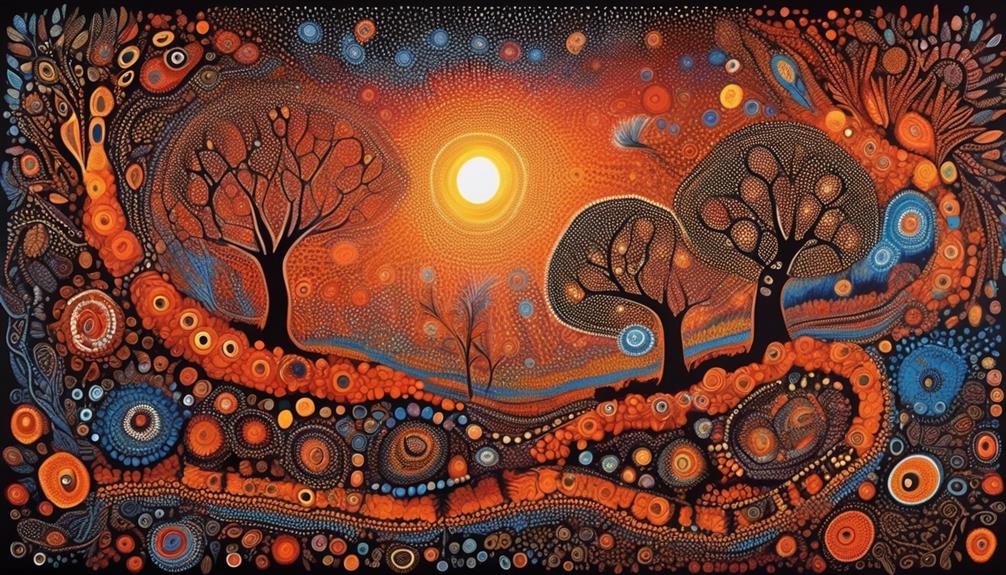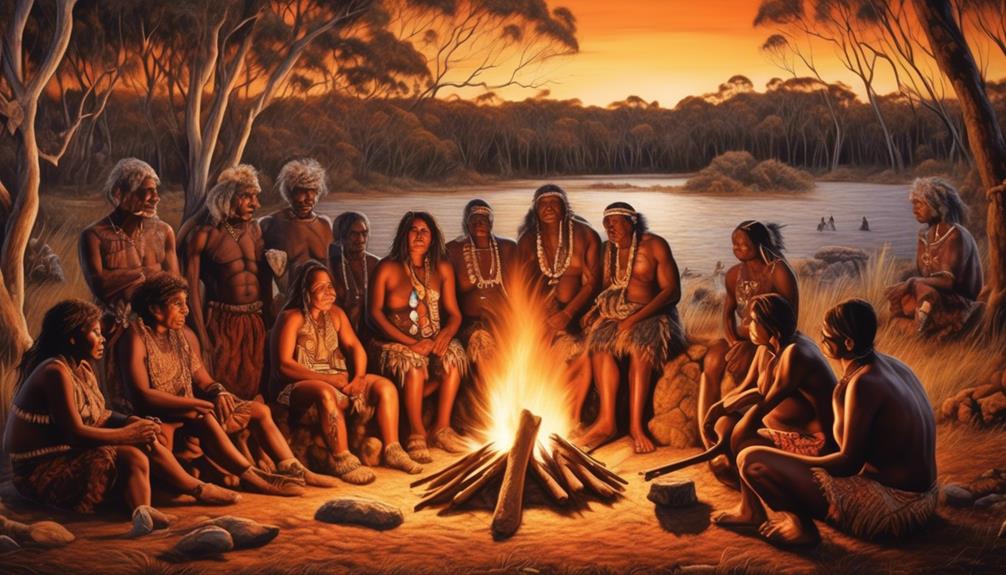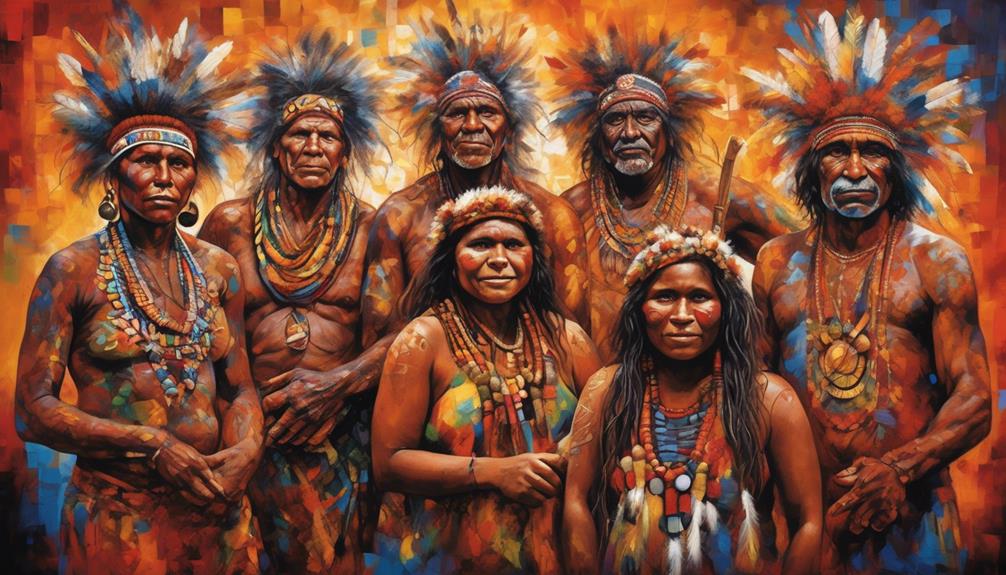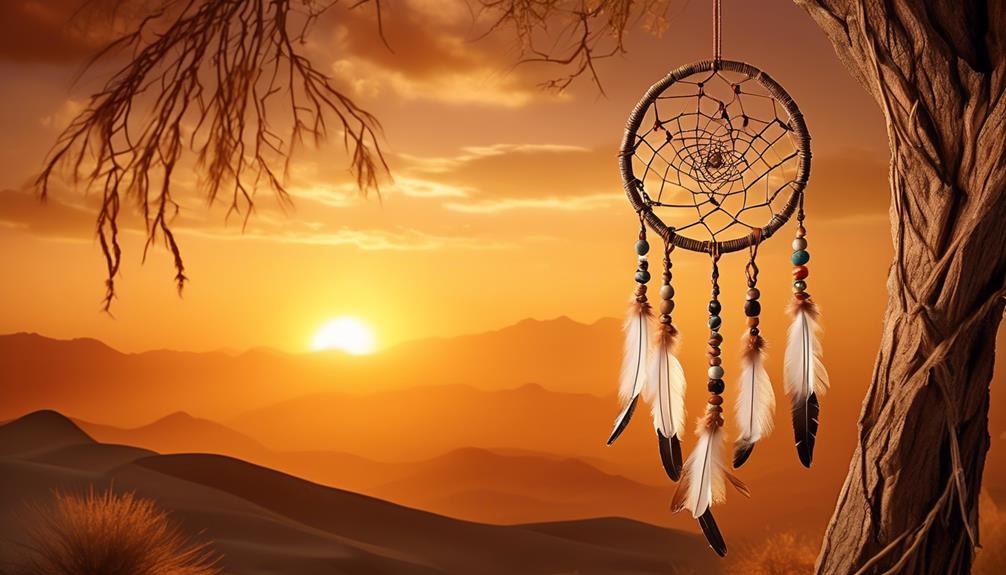The saying “Every person has a story to tell if you know how to listen” is very relevant to the fascinating aspect of totems in Aboriginal culture. This tradition offers insights into the deep and diverse traditions of Indigenous communities.
From animals and plants to elements and sacred objects, the array of Aboriginal totems is as varied as it is intriguing. Exploring the significance and symbolism of these totems provides a deeper understanding of the spiritual and cultural heritage of the Aboriginal people.
But what makes each totem unique and how do they continue to hold significance in contemporary society?
Key Takeaways
- Aboriginal totems play a significant role in traditional culture, representing kinship, spirituality, and cultural identity.
- Totems serve as a connection between individuals, communities, and the natural world, symbolizing ancestral lineage, identity, and offering protection and guidance.
- Modern interpretations of Aboriginal totems keep traditions relevant, promote cultural pride and diversity, and contribute to the preservation of Aboriginal culture.
- Efforts are being made to protect and preserve Aboriginal totems as important cultural assets, including their inclusion in heritage conservation initiatives and their potential contribution to reconciliation efforts.
Totem Animals in Australian Aboriginal Culture
In Australian Aboriginal culture, animals serve as totems, representing the kinship and spiritual connection of individuals and groups with the natural world. These totem animals hold deep symbolic meanings and cultural significance for the Aboriginal people. Each totem animal embodies unique qualities and characteristics that are believed to be inherited by the individuals or groups associated with them.
The totem animals are revered and respected, and they play a crucial role in shaping the identity and spirituality of the Aboriginal community.
The symbolic meanings attributed to totem animals vary widely, with some representing strength, courage, and protection, while others symbolize wisdom, creativity, and connection to the land. The cultural significance of these totem animals is evident in the rituals, ceremonies, and art forms of the Aboriginal people, where they're prominently featured as symbols of ancestral heritage and spiritual guidance.
Understanding the totem animals in Australian Aboriginal culture provides valuable insights into the rich tapestry of beliefs and traditions that have been passed down through generations, fostering a profound appreciation for the interconnectedness between humans, animals, and the natural world.
Plant and Nature Totems in Indigenous Communities
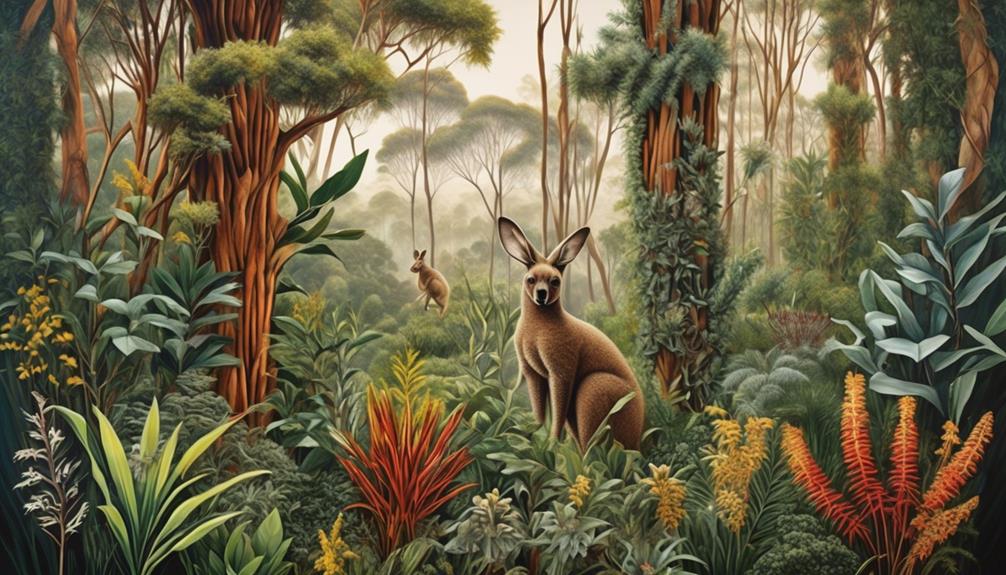
Plant and nature totems hold profound cultural significance in various indigenous communities around the world, symbolizing the interconnectedness between humanity and the natural world. In many indigenous cultures, specific plants are revered as totems due to their medicinal properties and the essential role they play in sustaining life. These totems aren't only symbolic but also practical, as they represent the deep understanding of the environment and the knowledge of medicinal plants that has been passed down through generations.
Medicinal plants have been a cornerstone of indigenous healthcare for centuries, with extensive knowledge of their properties and applications. These plants aren't only used for physical healing but are also deeply intertwined with spiritual and emotional well-being. The totems associated with these medicinal plants serve as a reminder of the importance of traditional healing practices and the deep connection between the natural world and human health.
Furthermore, plant and nature totems also reflect the indigenous communities' commitment to environmental conservation. These totems embody a profound respect for the Earth and all its inhabitants, promoting sustainable practices and the preservation of biodiversity. They remind us of the critical role that indigenous communities play in safeguarding the environment for future generations.
Elemental Totems in Aboriginal Traditions
Elemental totems hold significant cultural and spiritual importance in Aboriginal traditions, reflecting a deep reverence for the natural forces that shape their worldview. In Aboriginal spirituality, the elements of earth, water, fire, and air are considered essential and powerful aspects of existence. These elemental forces are believed to embody unique spiritual energies and are often embodied in totemic symbols. Here are some examples of elemental totems and their traditional symbolism:
| Element | Traditional Symbolism |
|---|---|
| Earth | Represents strength, stability, and the nurturing aspects of the land. It symbolizes the connection to the physical body, the environment, and the importance of grounding. |
| Water | Signifies purity, healing, and renewal. It is associated with emotions, intuition, and adaptability. Water totems emphasize the fluidity and flexibility needed to navigate life's challenges. |
| Fire | Symbolizes transformation, passion, and energy. It represents the spiritual aspects of the self, illumination, and the desire for change and growth. Fire totems inspire courage and resilience. |
| Air | Reflects intellect, freedom, and communication. It symbolizes the power of the mind, inspiration, and the ability to connect with the spiritual realm. Air totems encourage mental clarity and open-mindedness. |
These elemental totems are integral to Aboriginal cultures, embodying profound spiritual significance and traditional symbolism.
Sacred Objects as Aboriginal Totems

Sacred objects play a vital role in Aboriginal culture, serving as tangible manifestations of ancestral connections and spiritual guidance. These objects hold immense cultural significance, symbolizing the spiritual connection between the Aboriginal people and their ancestors. Traditional storytelling often revolves around these sacred objects, passing down their symbolic representation from generation to generation.
The deep-rooted spiritual connection to these objects fosters a sense of reverence and respect within the community, emphasizing their intrinsic value in preserving cultural heritage.
- Cultural Continuity: The use of sacred objects as Aboriginal totems ensures the continuity of cultural traditions, reinforcing the significance of ancestral wisdom and indigenous knowledge.
- Interconnectedness: These objects serve as a conduit for the interconnectedness between the physical and spiritual realms, fostering a profound sense of unity within the community.
- Ancestral Reverence: Through these sacred objects, Aboriginal communities honor and pay homage to their ancestors, maintaining a strong link to their past and heritage.
- Spiritual Guidance: The presence of sacred objects provides spiritual guidance, offering a sense of solace and direction in navigating life's complexities.
The preservation and reverence for these sacred objects perpetuate the rich tapestry of Aboriginal culture, encapsulating a timeless tradition of spiritual significance and cultural identity.
Contemporary Significance of Aboriginal Totems
The enduring significance of Aboriginal totems persists in contemporary times, embodying a cultural continuum that transcends generations and remains integral to the spiritual fabric of the community. In today's society, Aboriginal totems continue to hold profound cultural and spiritual significance. Modern interpretations of these totems reflect the adaptability of Aboriginal traditions to the present day, showcasing their relevance in a rapidly changing world. Cultural adaptations have allowed for the evolution of totems, aligning them with contemporary values and societal dynamics while preserving their traditional essence.
| Modern Interpretations | Cultural Adaptations |
|---|---|
| Incorporation of totemic symbols in contemporary art and design | Embracing new mediums such as digital art and multimedia to depict totems |
| Integration of totemic values in modern community initiatives | Adapting traditional totemic stories to resonate with current social issues |
| Use of totems in modern rituals and ceremonies | Balancing traditional totemic practices with contemporary spiritual beliefs |
| Application of totemic knowledge in environmental conservation efforts | Harnessing traditional ecological wisdom to address modern environmental challenges |
| Incorporating totemic teachings in educational programs | Adapting totemic teachings to address current social and cultural issues |
These modern interpretations and cultural adaptations ensure that the significance of Aboriginal totems remains not only preserved but also relevant in today's society, fostering a deeper understanding of these ancient traditions while integrating them into contemporary life.
Frequently Asked Questions
How Do Aboriginal Communities Determine Which Totem Animal or Plant Is Associated With a Particular Individual or Group?
We determine totem animals or plants in Aboriginal communities through a process that considers cultural significance and personal connections. Totem determination involves deep understanding of the natural world and its spiritual meanings.
This representation reflects the individual or group's identity and history. The process is intricate and varies among different communities, but always involves a profound respect for the natural world and its place in our lives.
Are There Specific Rituals or Ceremonies Related to the Identification or Honoring of Totem Animals and Plants in Aboriginal Culture?
Ritual significance and cultural significance are crucial aspects of aboriginal traditions. Specific ceremonies and rituals are integral to the identification and honoring of totem animals and plants. These rituals hold deep cultural significance and are often passed down through generations. They're essential for connecting individuals and communities with their totemic symbols, fostering a profound sense of belonging and spiritual connection.
These practices play a vital role in preserving and celebrating aboriginal cultural heritage.
What Role Do Elemental Totems Play in Everyday Aboriginal Life and Spiritual Practices?
Elemental totems hold significant spiritual relevance in everyday Aboriginal life. Traditional beliefs intertwine cultural integration with the selection of totems representing natural elements. The spiritual significance of these totems is evident in community rituals that honor and connect with the earth, water, fire, and air.
These totems serve as guides, providing wisdom and strength, enriching our existence through their profound connection to the natural world.
How Are Sacred Objects Chosen and Designated as Important Totems Within Aboriginal Communities?
Sacred objects are chosen and designated as important totems within Aboriginal communities based on their cultural significance and traditional practices. The selection process involves careful consideration of the object's symbolic representation and its ability to establish a spiritual connection.
This designation is a deeply revered aspect of Aboriginal culture, reflecting the community's values and beliefs. The totem's role in shaping individual and collective identity is integral to the spiritual and cultural fabric of Aboriginal life.
What Are Some Modern Examples of How Aboriginal Totems Are Integrated Into Contemporary Society and Cultural Practices?
Integrating aboriginal totems into contemporary society and cultural practices involves various modern examples.
For instance, we see totems incorporated into public art installations, community events, and educational programs.
These totems serve as a powerful reminder of our connection to the land and our ancestors.
Conclusion
In conclusion, the diverse range of Aboriginal totems reflects the deep connection to the natural world and the spiritual significance of animals, plants, and elements.
These totems continue to play a significant role in Indigenous communities, serving as symbols of identity, connection, and tradition.
As we continue to learn and appreciate the rich cultural heritage of Aboriginal totems, we gain a deeper understanding of the profound wisdom and respect for the natural world that has been passed down through generations.
Nayeli is our dedicated Editor in Chief, bringing her passion for words and keen editorial eye to every piece of content we produce. With years of experience in the field, she ensures that every article and publication meets the highest standards of quality and clarity. Nayeli’s commitment to storytelling and her deep understanding of our mission make her an invaluable leader in our team.

